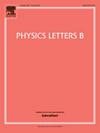Pseudorapidity distributions of charged hadrons in lead-lead collisions at sNN=5.36TeV
IF 4.3
2区 物理与天体物理
Q1 ASTRONOMY & ASTROPHYSICS
引用次数: 0
Abstract
The pseudorapidity (η) distributions of charged hadrons are measured using data collected at the highest ever nucleon-nucleon center-of-mass energy of for collisions of lead-lead ions. The data were recorded by the CMS experiment at the LHC in 2022 and correspond to an integrated luminosity of . Using the CMS silicon pixel detector, the yields of primary charged hadrons produced in the range are reported. The evolution of the midrapidity particle density as a function of collision centrality is also reported. In the 5% most central collisions, the charged-hadron η density in the range is found to be , with negligible statistical uncertainty. This result is consistent with an extrapolation from nucleus-nucleus collision data at lower center-of-mass energies. Comparisons are made to various Monte Carlo event generators and to previous measurements of lead-lead and xenon-xenon collisions at similar collision energies. These new data detail the dependence of particle production on the collision energy, initial collision geometry, and the size of the colliding nuclei.
求助全文
约1分钟内获得全文
求助全文
来源期刊

Physics Letters B
物理-物理:综合
CiteScore
9.10
自引率
6.80%
发文量
647
审稿时长
3 months
期刊介绍:
Physics Letters B ensures the rapid publication of important new results in particle physics, nuclear physics and cosmology. Specialized editors are responsible for contributions in experimental nuclear physics, theoretical nuclear physics, experimental high-energy physics, theoretical high-energy physics, and astrophysics.
 求助内容:
求助内容: 应助结果提醒方式:
应助结果提醒方式:


